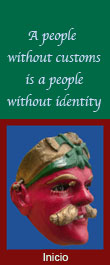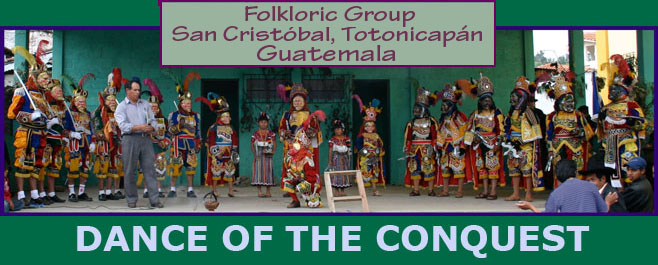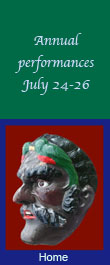Introduction to the Folkloric Group in San Cristóbal
What is the Dance of the Conquest?
The Dance of the Conquest is a public ritual drama that portrays the K’iche’ kingdom as it was in 1524, introducing the king K’iq’ab’ and his heir, prince Tekum, whose priest, diviner and spiritual advisor is Ajitz. The drama tells of the Spanish invasion led by Pedro de Alvarado under orders from Hernán Cortés, and it tells of the heroic defense mounted by Tekum, killed in battle by Alvarado. The story concludes with the K’iche’ people accepting the Christian faith.
The text for this drama was likely written in the late 16th or early 17th century by a franciscan missionary at Xela or Salcajá, who designed it in part to foster Maya conversion to Catholicism. However, over the centuries Maya dance groups have added to its message, using the dance to express concerns for remembering their history, celebrating costumbre (Maya-Catholic religion), honouring their patron saint, maintaining their distinct identity, and resisting oppression and exploitation.
This website provides a brief introduction to the Dance of the Conquest as it is performed in San Cristóbal Totonicapán, Guatemala. For an in-depth analysis of this dance that involves a broader selection of communities and an investigation into its 400-year history, see the website: The Dance of the Conquest of Guatemala in Four K’iche’ Communities
Where is San Cristóbal Totonicapán?
San Cristóbal is a municipality in the department of Totonicapán. The cabecera or town of San Cristobal is located on the Pan-American highway, less than a kilometer from “Cuatro Caminos”, the intersection of this highway with those leading west to Xela (Quetzaltenango) and east to San Miguel Totonicapán, the department capital.
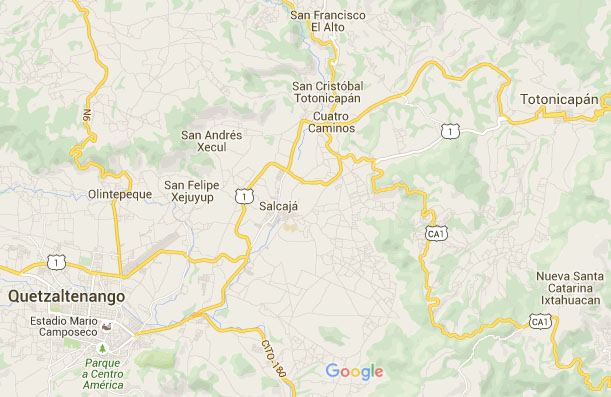
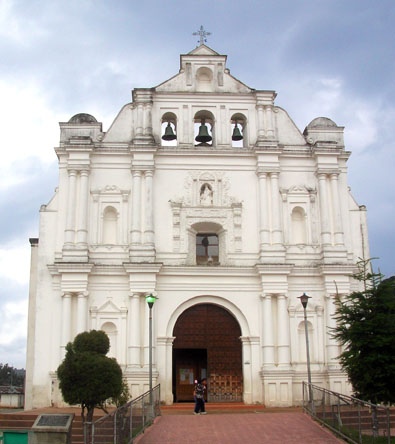
In ancient times, before the arrival of the Spanish conquistadores, the community of San Cristóbal Totonicapán was called “Pahula”, which in the K’iche’ language means waterfall, recognizing the waterfalls that are today admired by the entire country of Guatemala.
San Cristóbal Totonicapán is characterized by its cultural and religious treasures, consideing the many different performances and other activities that take place throughout the year and that are appreciated by Guatemalan and foreign tourists.
The church of San Cristóbal, Totonicapán is a colonial period gem with some preserved original mural paintings.
The Folkloric Dance Group of San Cristóbal Totonicapán
 One of the attractions that has characterized this municipality for many years is the performance of the dance and poetry of the famous Dance of the Conquest, which is presented each year, on the 24-26 of July, to honor San Cristóbal during the annual patron saint festival.
One of the attractions that has characterized this municipality for many years is the performance of the dance and poetry of the famous Dance of the Conquest, which is presented each year, on the 24-26 of July, to honor San Cristóbal during the annual patron saint festival.
The Dance of the Conquest Folkloric group of San Cristóbal Totonicapán was founded on April 12, 1915. According to its history, the founding director was Tomás Sabaj, who began rehearsals in May of that years. This tradition has been carried on to the present. Also, in the early years of the group, six Maya ceremonies were performed: three during the rehearsal period; one at the blessing of the costumes, one during the fair, and one at its conclusion.
Autor and/or Director of the Group |
Years of Service |
Tomás Sabaj |
1915-1920 |
José Mejía |
1921-1925 |
Ramón Peñalonzo |
1926-1930 |
Pedro Pastor Choz |
1931-1935 |
Martín Navarro |
1936-1940 |
Emilio Sosa |
1941-1944 |
Diego Castro |
1945-1950 |
Sofío Cuc |
1951-1966 |
Juan Sabaj |
1967-1978 |
Rocael Chuc y José María Cuc |
1979-1985 |
Francisco Rodolfo Hernández |
1986- a la Fecha |
This Grupo Folklórico consists of 23 members, with a directive committee elected annually from among its members and collaborators. Francisco Hernández was appointed leader of this dance group in 1981. He has also been performing the role of Ajitz since 1973. He serves as sponsor (autor) of the dance group, responsible for organizing rehearsals and fostering enthusiasm and harmony among the participants. He also serves as the instructor (maestro), teaching participants the lengthy text and varied dance steps. And he serves as the group’s priest (ajq’ij), officiating at ceremonies.
In June, 2015, the Grupo Folklórico Baile de la Conquista celebrated its centenary with prayers, music of the marimba as well as chirimía and tambor, and with speeches by members of the group and civil authorities.

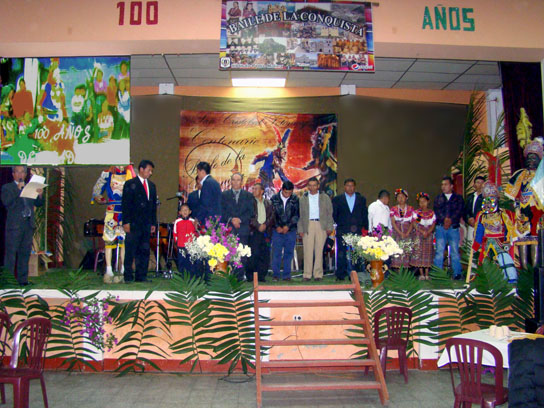
Financial Support Needed
The Folkloric Group of San Cristóbal is sustained through contributions by its members and persons from the public sector who still appreciate and support this tradition at a time when many Maya and entire municipios have ceased to participate.
The Folkloric Group encourages donations from public or private entities, national or international, not only for general production costs but also because we would like to commission costumes that are more appropriate to the historical period recounted in this dance and to the ethnic identities involved. We believe that greater historical authenticity may be a key to revitalizing this ancient tradition at a time of social and economic transformation.
Juan Hernández
To find out how you can help support the Folkloric Group of San Cristobal, write: juanoswal40@yahoo.com
